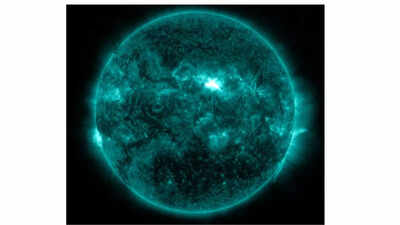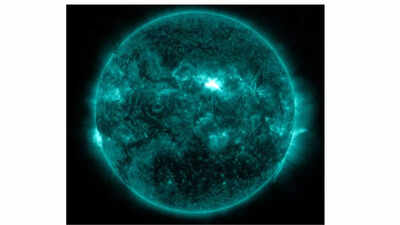Sun emits strongest solar flare of the year, causing radio blackouts and communication disruptions, reports NASA |

In a burst of solar activity, NASA has said that sunspot region 4114 has unleashed the most powerful solar flare of 2025 so far. Classified as an X1.2-class flare, the most intense category, the eruption occurred on 17 June and triggered widespread shortwave radio blackouts, especially over the Pacific Ocean, including areas such as Hawaii. The flare disrupted frequencies below 25 MHz, affecting communication for aviators and ham radio operators. Although it was not accompanied by a coronal mass ejection (CME), which typically intensifies geomagnetic storms, the flare’s sheer intensity was enough to disturb the Earth’s ionosphere. Scientists remain on high alert as the active sunspot continues to face Earth.
What is an X-class solar flare detected by NASA
Solar flares are powerful bursts of radiation from the Sun, and X-class flares are the strongest among them. An X1.2 flare, like the one recorded, is over ten times more intense than an M1-class flare. These events can cause temporary blackouts in the Earth’s upper atmosphere by ionising it, disrupting radio signals and communication technologies.
What it means for Earth’s communications systems
While this flare did not pose a direct threat to life on Earth, it serves as a strong reminder of the Sun’s volatile nature. Disruptions to communication, navigation systems, and satellites are possible with flares of this strength, especially if a CME is involved in future eruptions. Space weather experts continue to monitor the Sun’s activity in real time to prepare for any further disruptions.
No CME, but still troubling radio systems and other communications
Unlike some previous eruptions, this solar flare was not accompanied by a coronal mass ejection or CME. CMEs are plasma clouds that can cause geomagnetic storms and auroras when they strike Earth’s magnetic field. Despite this, the flare was intense enough to disturb communications and is being closely monitored for any follow-up activity.
Region 4114: a solar flare factory
Sunspot region 4114 has been unusually active. According to NOAA and spaceweather.com, it has fired multiple M-class flares in recent days. While its magnetic field has slightly weakened, it still has the potential to emit more M-class or even X-class flares shortly. The sunspot remains Earth-facing, keeping forecasters and scientists alert.
A sign of the solar maximum
This event aligns with the current phase of the Sun’s 11-year solar cycle, known as the solar maximum. During this period, sunspot activity increases dramatically, making powerful flares like these more likely. NASA and NOAA suggest that this phase began in late 2024 and could peak in 2025.





